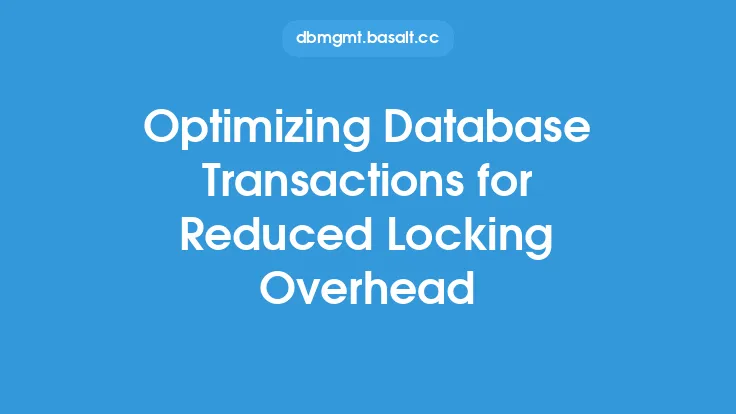Database systems use locking mechanisms to manage concurrent access to shared resources, ensuring data consistency and integrity. Locking is a crucial aspect of database performance optimization, as it prevents multiple transactions from modifying the same data simultaneously, which could lead to inconsistencies and errors. In this article, we will delve into the world of locking mechanisms in database systems, exploring their types, characteristics, and implications on database performance.
Introduction to Locking Mechanisms
Locking mechanisms are used to synchronize access to shared resources, such as tables, rows, or indexes, in a database. When a transaction requests access to a resource, the database system checks if the resource is already locked by another transaction. If it is, the requesting transaction must wait until the lock is released. Locking mechanisms ensure that transactions are executed in a way that maintains data consistency and prevents conflicts.
Types of Locks
There are several types of locks used in database systems, each with its own characteristics and uses. The most common types of locks are:
- Shared locks: Allow multiple transactions to read the same resource simultaneously, but prevent any transaction from modifying the resource until all shared locks are released.
- Exclusive locks: Prevent any other transaction from accessing the resource, either for reading or modifying, until the exclusive lock is released.
- Intent locks: Indicate that a transaction intends to acquire a shared or exclusive lock on a resource, but do not actually lock the resource.
- Schema locks: Prevent any changes to the schema of a resource, such as altering a table or index, until the schema lock is released.
Lock Granularity
Lock granularity refers to the level of detail at which locks are applied. Database systems can use various levels of lock granularity, including:
- Row-level locking: Locks individual rows within a table, allowing multiple transactions to access different rows simultaneously.
- Page-level locking: Locks entire pages of data, which can contain multiple rows, reducing the overhead of row-level locking.
- Table-level locking: Locks entire tables, preventing any transactions from accessing the table until the lock is released.
- Database-level locking: Locks the entire database, preventing any transactions from accessing the database until the lock is released.
Lock Duration
Lock duration refers to the length of time a lock is held by a transaction. Database systems can use various lock durations, including:
- Short-term locks: Held for a short period, typically until the end of a transaction.
- Long-term locks: Held for an extended period, potentially spanning multiple transactions.
- Persistent locks: Held until explicitly released, even if the transaction that acquired the lock has completed.
Locking Modes
Locking modes determine how locks are acquired and released. The most common locking modes are:
- Pessimistic locking: Assumes that conflicts will occur and acquires locks to prevent them.
- Optimistic locking: Assumes that conflicts will not occur and only acquires locks when necessary.
- Lazy locking: Delays acquiring locks until the last possible moment, reducing overhead but increasing the risk of conflicts.
Implications on Database Performance
Locking mechanisms can significantly impact database performance, both positively and negatively. On the positive side, locking ensures data consistency and prevents conflicts. However, excessive locking can lead to:
- Lock contention: When multiple transactions compete for the same lock, leading to delays and reduced throughput.
- Deadlocks: When two or more transactions are blocked, each waiting for the other to release a lock.
- Lock overhead: The additional processing required to manage locks, which can reduce database performance.
Best Practices for Locking Mechanisms
To optimize locking mechanisms and minimize their impact on database performance, follow these best practices:
- Use the appropriate lock type: Choose the lock type that best fits the needs of your application, considering factors such as concurrency and data consistency.
- Optimize lock granularity: Select the optimal level of lock granularity to balance concurrency and overhead.
- Minimize lock duration: Release locks as soon as possible to reduce contention and overhead.
- Monitor and analyze locking activity: Regularly monitor and analyze locking activity to identify potential issues and optimize locking mechanisms.
Conclusion
Locking mechanisms are a crucial aspect of database systems, ensuring data consistency and preventing conflicts in concurrent environments. Understanding the types, characteristics, and implications of locking mechanisms is essential for optimizing database performance. By following best practices and carefully considering the trade-offs between concurrency, consistency, and overhead, database administrators and developers can design and implement effective locking mechanisms that support high-performance and scalable database systems.





